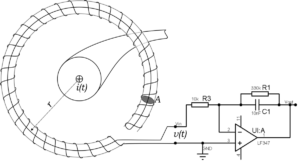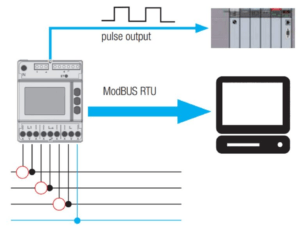The Rogowski coil (Rogowski coil) is an electrical device for measuring alternating and impulse currents, used as an alternative to current transformers (TA). The device consists of a conductor cable neatly wound in helical form on a flexible support, to form a coil (solenoid) of suitable length. One end of the solenoid is returned to the origin of the coil by passing the return cable inside the solenoid itself. This construction allows to keep one end of the coil free, and in this way it can be easily wound around a current flow you want to measure, avoiding to interfere with it.
From the operating point of view, the output voltage is proportional to the speed of current variation and, after an integrating circuit, it is proportional to the value of the current itself (as for a current transformer).

Rogowski coil surrounding a power-bearing cable. The coil output, V(t), is connected to an integrator circuit to obtain a voltage Vout(t) proportional to I(t).
In the Rogowski coil the junction point is insensitive to both the position of the inner conductor and the currents of outer conductors, while coil and cable shielded against electromagnetic noise. It is also a very precise device (typically has accuracy better than 1% even close to the coil closure point) and with an easily accessible calibration point.
Mechanically ensures a secure closure even in the presence of vibrations and traction, as well as stable (which ensures repeatability in the measurement).

Typical wiring diagram with Rogowski coil insertion
The advantages of Rogowski’s coil
- Suitable for measuring currents up to hundreds of kA
- Very useful with large or irregularly shaped conductors or in poorly accessible places
- Non-intrusive, does not absorb power from the circuit under measurement
- Characterized by high linearity
- Easy coupling to the conductor to be measured
Rogowski vs CT
The Rogowski sensors therefore compete with current transformers in application contexts current transformers (CT) dedicated to the measurement, standardization and conversion of alternating or direct current, in combination with meters, analyzers, meters, electrical loads, control relays, etc.

